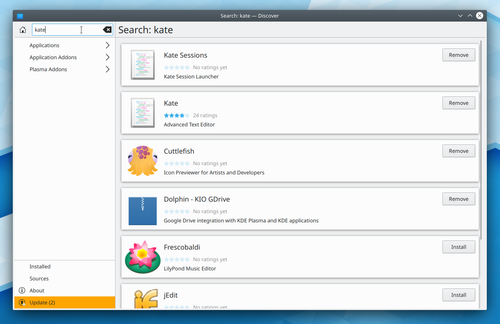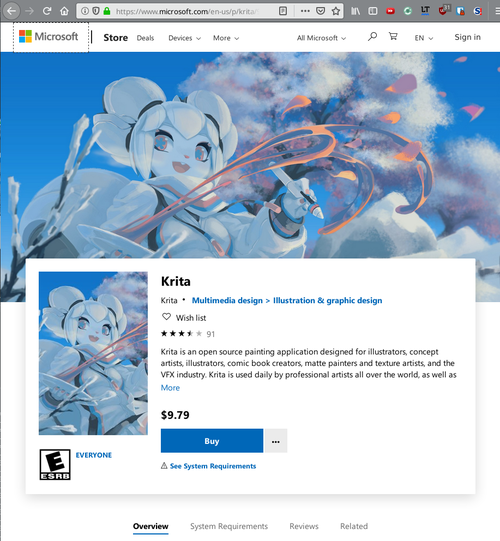Tutorials/Install KDE software/de: Difference between revisions
Created page with "== Mit der Kommandozeile (Terminal) ==" |
Created page with "== Unter Verwendung einer grafischen Oberfläche == === Discover ===" |
||
| Line 7: | Line 7: | ||
{{Tip|1=When you see mono-spaced text on a gray background <code>like this</code> that is something that you need to type in, exactly as it appears there.}} | {{Tip|1=When you see mono-spaced text on a gray background <code>like this</code> that is something that you need to type in, exactly as it appears there.}} | ||
<span id="Using Package Managers"></span> | <span id="Using Package Managers"></span> | ||
== | == Unter Verwendung einer grafischen Oberfläche == | ||
=== Discover === | === Discover === | ||
Revision as of 12:12, 7 April 2020
KDE Software installieren
To install KDE software we recommend using the means of your distribution. Here is how you find your distribution's name and version.
Unter Verwendung einer grafischen Oberfläche
Discover
Discover is the KDE Software Center and work with all the distribution supporting appstream (Ubuntu, Debian, Arch-Linux, OpenSUSE, Red Hat, Fedora, ...). If you want more info about discover, visit the discover page.

openSUSE - YaST
In openSUSE, you have the choice between using discover and YaST software management tool.
You find openSUSE's package management tool in the tab of the start menu. Open that and click on the icon to start the package manager.

Use the search field to find the package that you wish to install; you can search on the package name or the package description, and you only need to enter part of the name. You will then be presented with a list of packages matching your search. Click the selection boxes for the packages to be installed and then click . See this page for more on package management and openSUSE.
Windows Store
Some KDE applications are also available in the Windows Store. For example, you can buy Krita a digital painting software or KStars.

Mit der Kommandozeile (Terminal)
If you find that using a package manager is unbearably slow, you will want to use command-line installation. This is much faster, but the disadvantage is that you need to know the exact name of the package you want to install. Each system has helpful commands for searching, for instance, so try using the first word of install command below, with --help appended. As an example, yum --help will list the commands you can use for Fedora, but they are many and can be confusing at first.
openSUSE
In openSUSE wird Software unter Verwendung von "'zypper'" installiert. Um beispielsweise KWrite zu installieren, müssen Sie ein Terminal öffnen und zypper in kwrite eingeben.
Ubuntu
In Ubuntu wird Software unter Verwendung von "'apt'" installiert. Um beispielsweise KWrite zu installieren, müssen Sie ein Terminal öffnen und sudo apt install kwrite eingeben.
Fedora
Fedora verwendet "'yum'" zur Installition von Software. Um beispielsweise KWrite zu installieren, müssen Sie ein Terminal öffnen und yum install kwrite eingeben. Wenn Sie sich unsicher sind, wie der Name eines Paketes ist, können Sie unter Verwendung von "yum list" mit Platzhaltern alle Pakete, deren Name das eingegeben Word enthält, anzeigen lassen — z. B. listet yum list *network* alle verfügbaren Pakete auf, deren Name "network" enthält. Um noch ausführlicher zu suchen, können Sie mit yum search mpeg alle Pakete anzeigen lassen, bei denen entweder der Name oder die Beschreibung des Paketes mpeg enthält.
Gentoo
Gentoo verwendet "'emerge'" zur Installition von Software. Um beispielsweise KWrite zu installieren, müssen Sie ein Terminal öffnen und emerge --ask kwrite eingeben (verwenden Sie --ask um eine Überblick über Notwendige Abhängigkeiten zu erhalten und die USE flag Option vor dem Bestätigen). Wenn Sie sich unsicher sind, wie der Name eines Paketes ist, können Sie unter Verwendung von "emerge --search" alle Pakete, deren Name das eingegeben Word enthält, anzeigen lassen — z. B. listet emerge --search network alle verfügbaren Pakete auf, deren Name "network" enthält.
Mageia
You can use urpmi to install KDE software from a command line. Other useful commands can be found at Wikipedia's Urpmi page
OpenMandriva Lx
Most KDE software is installed already - you can use dnf to install additional packages. If you know what a package is called, you can use e.g. dnf --refresh install kwrite. If you don't know the package name, you can use dnf --refresh search '*kde*' to search (this example lists all packages that have "kde" as part of their name or description).
You can also use discover or dnfdragora as graphical frontends to package installation.
Arch linux and Manjaro
With Arch linux and arch linux based distribution like Manjaro, you can install software using the pacman utility. For example to install KWrite you will open a console and enter
sudo pacman -S kwrite

